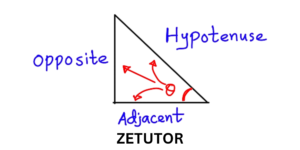TRIGONOMETRY
Trigonometry is a branch of mathematics that connects with the angles and sides of a triangle. There are three major trigonometric functions. Sine(sin), Cosine(cos), Tangent(tan), and there are three minor trigonometric functions Cosent(csc), Secant(sec), and Cotangent(cot).

You can use this SOH, CAH, TOA to memorize the following
sin\theta=\frac{Opposite}{Hypotenuse}
tan\theta=\frac{Opposite}{Adjacent}
csc\theta=\frac{Hypotenuse}{Opposite}
sec\theta=\frac{Hypotenuse}{Adjacent}
cot\theta=\frac{Adjacent}{Opposite}
Major trigonometric and minor trigonometric are connected by the equations given below. Sin, Cos, Tan are the reciprocal of Csc, Sec, Cot respectively and vise versa.
csc \theta =\frac{1}{sin \theta}
sec \theta =\frac{1}{cos \theta}
cot \theta =\frac{1}{tan \theta}
Types Of Triangle
By Angle
1. Acute Triangle (less than 90 degrees)
2. Right Triangle (Equals to 90 degrees)
3. Obtuse Triangle (Greater than 90 degrees)
By Side
1. Equilateral Triangle
2. Isosceles Triangle
3. Scalene Triangle
Basic trigonometric basic function equations can be only used for right triangles. Sine law, Cosine law can be used for any types of triangles.
Pythagorean Theorem
The Pythagorean theorem is a fundamental mathematical equation that connects the sides and angles of a right triangle. It states that in a right triangle. The square of lengths of the hypotenuse is equals to the sum of squares of the length of the other two sides
a^2+b^2=c^2c is the hypotenuse and a,b are the other two sides
Pythagorean theorem has various application in trigonometry and other part of mathematics. By combining trigonometric functions with Pythagorean theorem we can do the following things.
- Trigonometric Ratios
- Verifying trigonometric identities
- Angle of elevations and depressions
- Solving triangles
Ranges Of Trigonometric Functions
The ranges of the trigonometric functions depend on their equations and type of the functions and the nature of the unit circle.
1.SIne Function Range (SIN)
Range: [-1,1]
Sine functions can take values in between positive 1 and negative 1. Sine function represents the y coordinate of a unit circle.
2.Cosine Function Range (COS)
Range: [-1,1]
Cosine functions can take values in between positive 1 and negative 1. Cosine function represents the x coordinate of a unit circle.
3.Tangent Function Range (TAN)
Range: [ -\infty,\infty ]
Tangent functions can take all real number values. That’s why the range is in between negative infinity and positive infinity. Tangent functions can be found when you divide the sine function by cosine function.
tan \theta =\frac{sin\theta}{cos\theta}
4. Cosecant Function Range (CSC)
Range: \left ( -\infty,1 \right]\cup \left [1,\infty \right)
Cosecant functions are the reciprocal of sine functions. Cosecant function can not take zero because cosecant zero is undefined.
5. Secant Function Range (SEC)
6. Cotangent Function Range (COT)
Range: [ -\infty,\infty ]
cot \theta =\frac{cos\theta}{sin\theta}
Fundamental Trigonometric Identities
Trigonometric identities are fundamental trigonometric equations that used to simplify expressions and solve equations.
Reciprocal identities
csc \theta =\frac{1}{sin \theta}
sec \theta =\frac{1}{cos \theta}
cot \theta =\frac{1}{tan \theta}
Quotient Identities
tan \theta =\frac{sin\theta}{cos\theta}
cot \theta =\frac{cos\theta}{sin\theta}
Pythagorean Identities
sin^{2}\theta=1-cos^{2}\theta
sec^{2}\theta=1+tan^{2}\theta
csc^{2}\theta=1+cot^{2}\theta
Even Identities
Sum And Difference Identities
sin (A + B) = sinA cosB + cosA sinB
sin (A – B) = sinA cosB – cosA sinB
cos (A + B) = cosA cosB – sinA sinB
cos (A – B) = cosA cosB + sinA sinB
tan(A+B) = \frac{tanA+tanB}{1-tanAtanB}
tan(A-B) = \frac{tanA-tanB}{1+tanAtanB}
